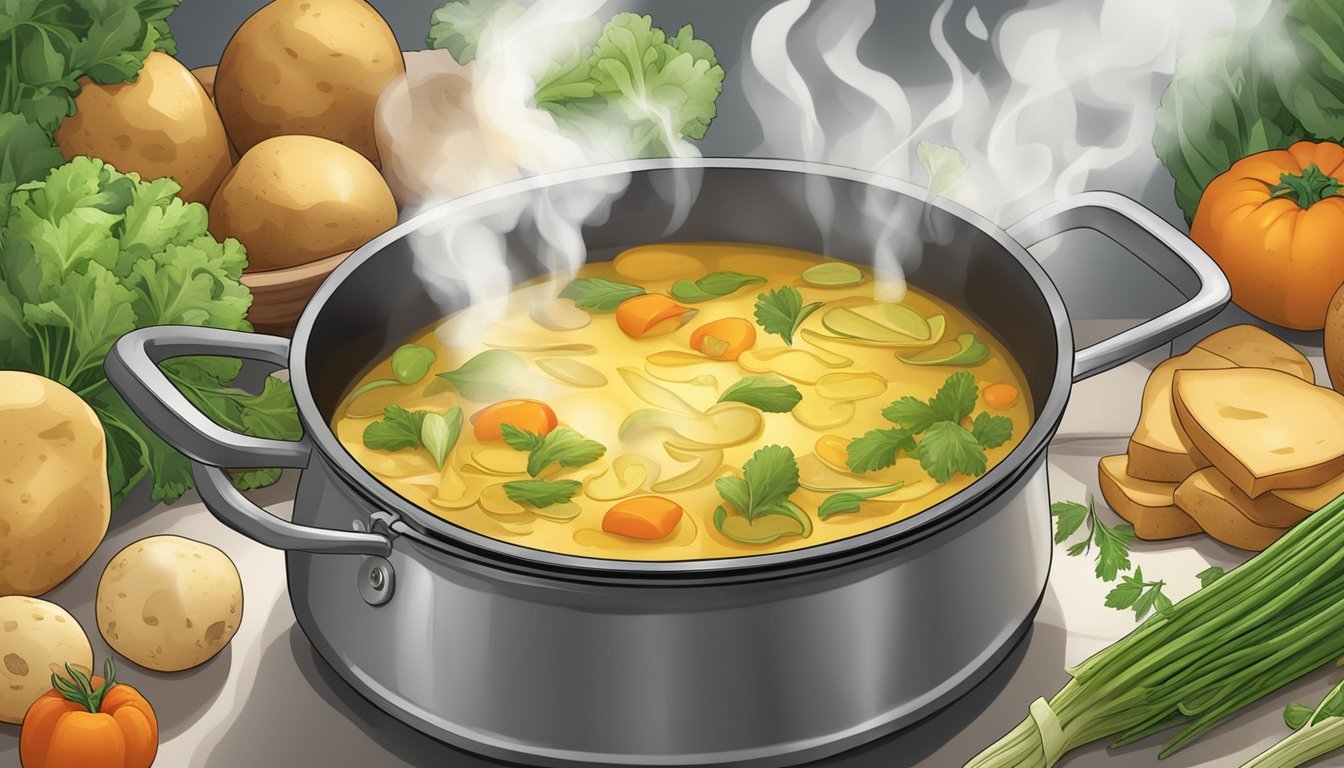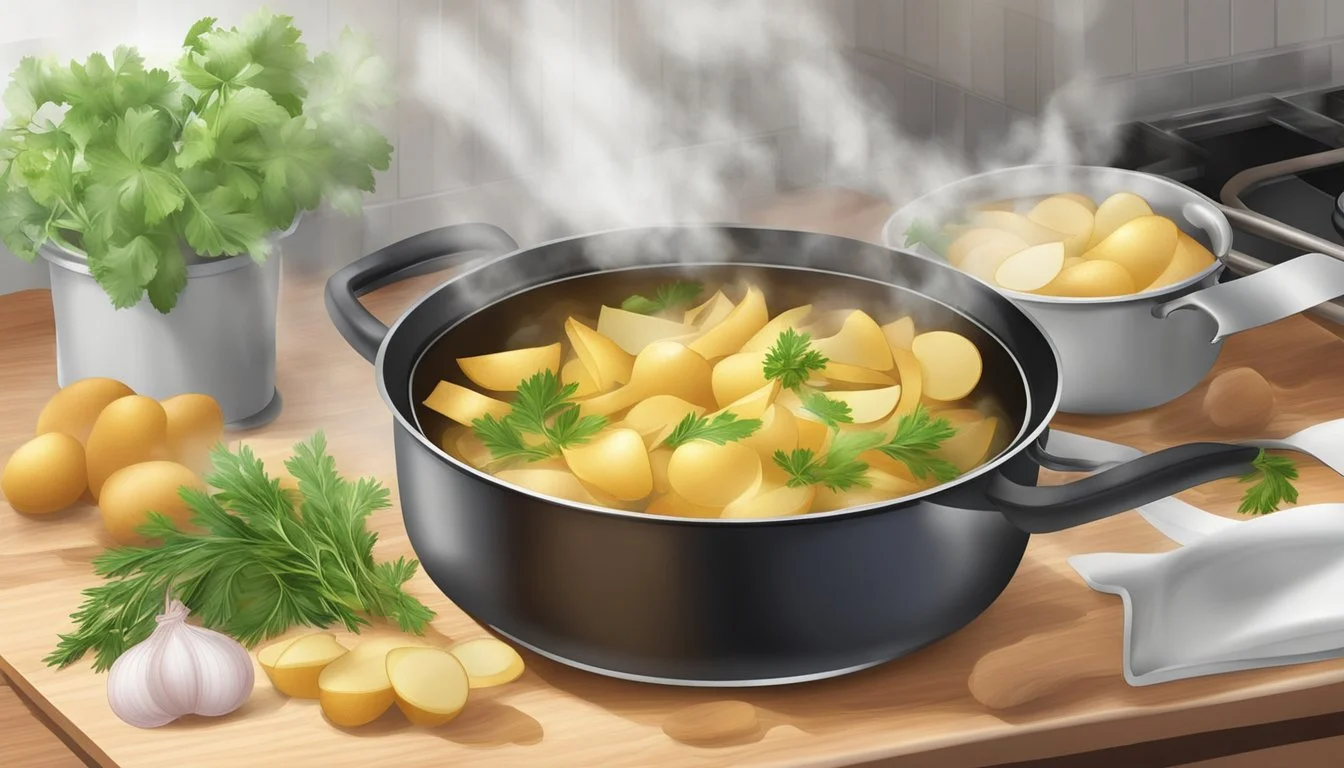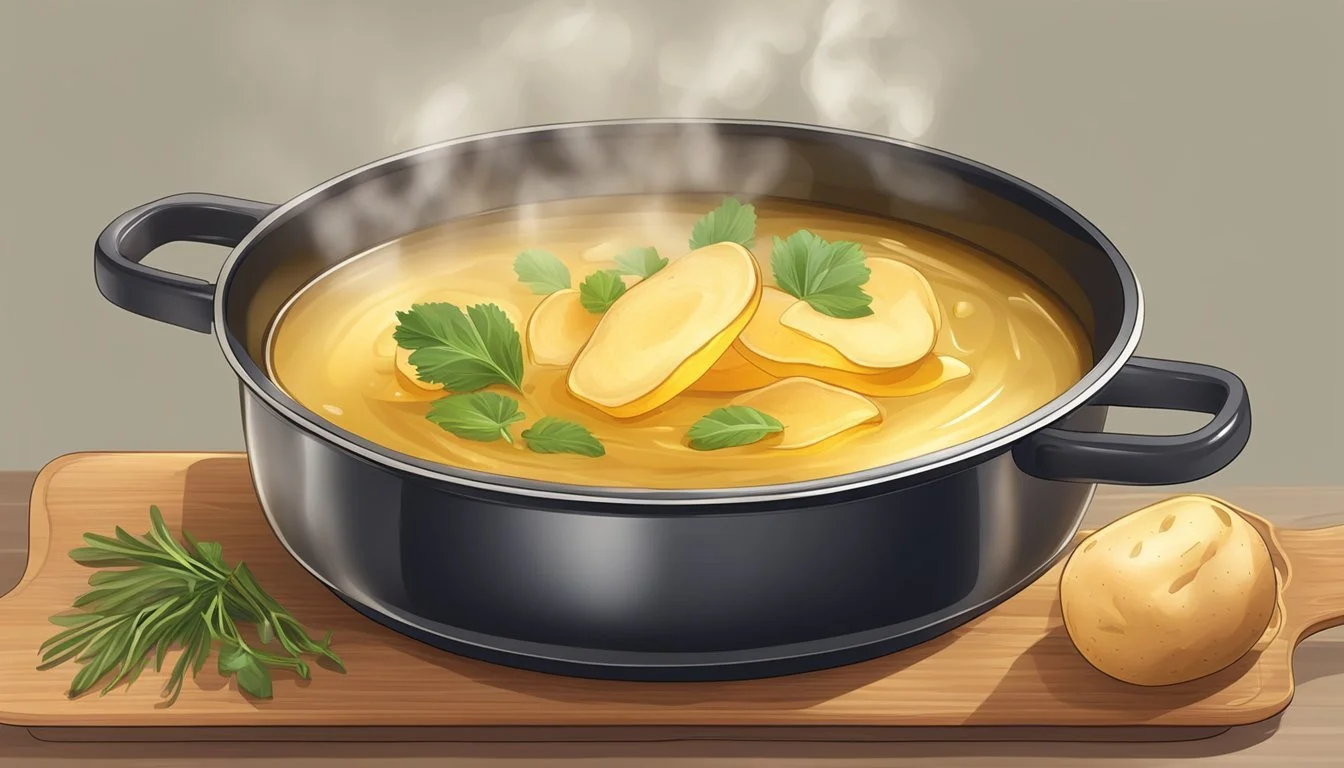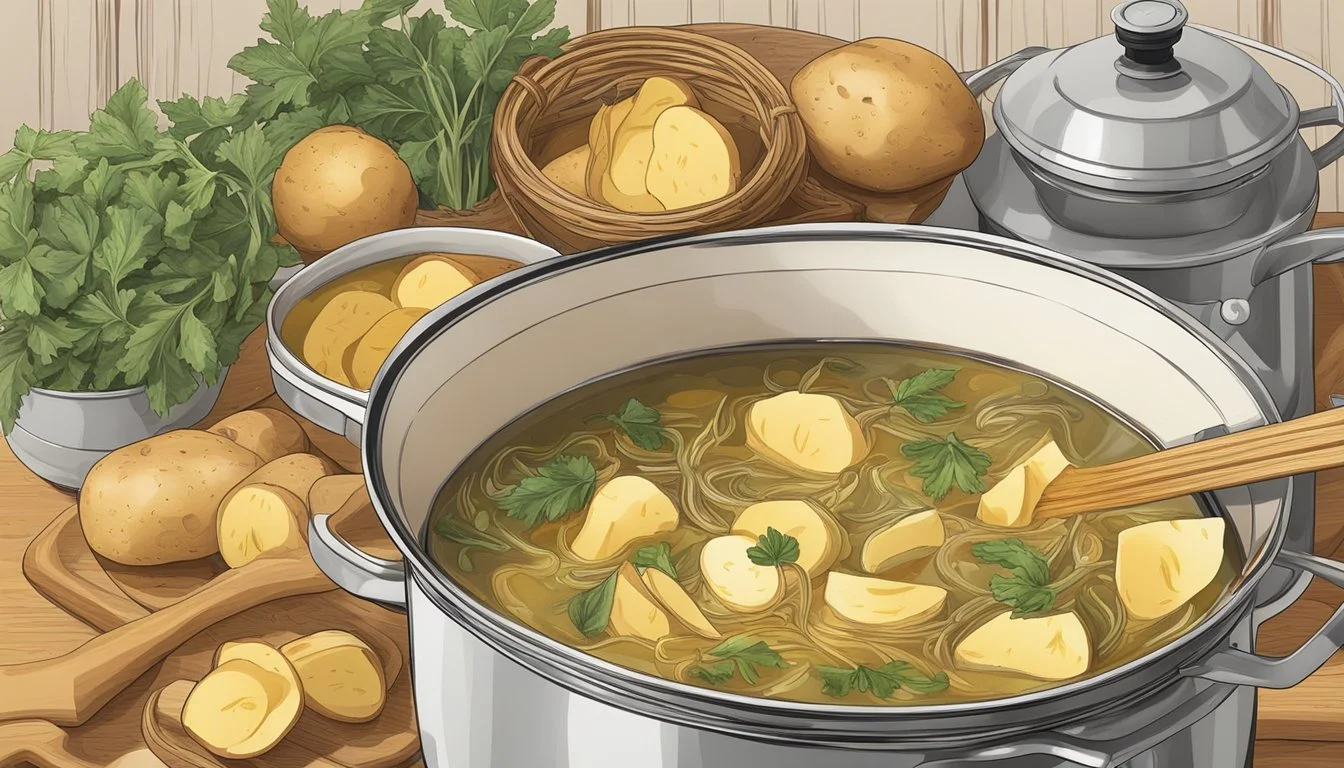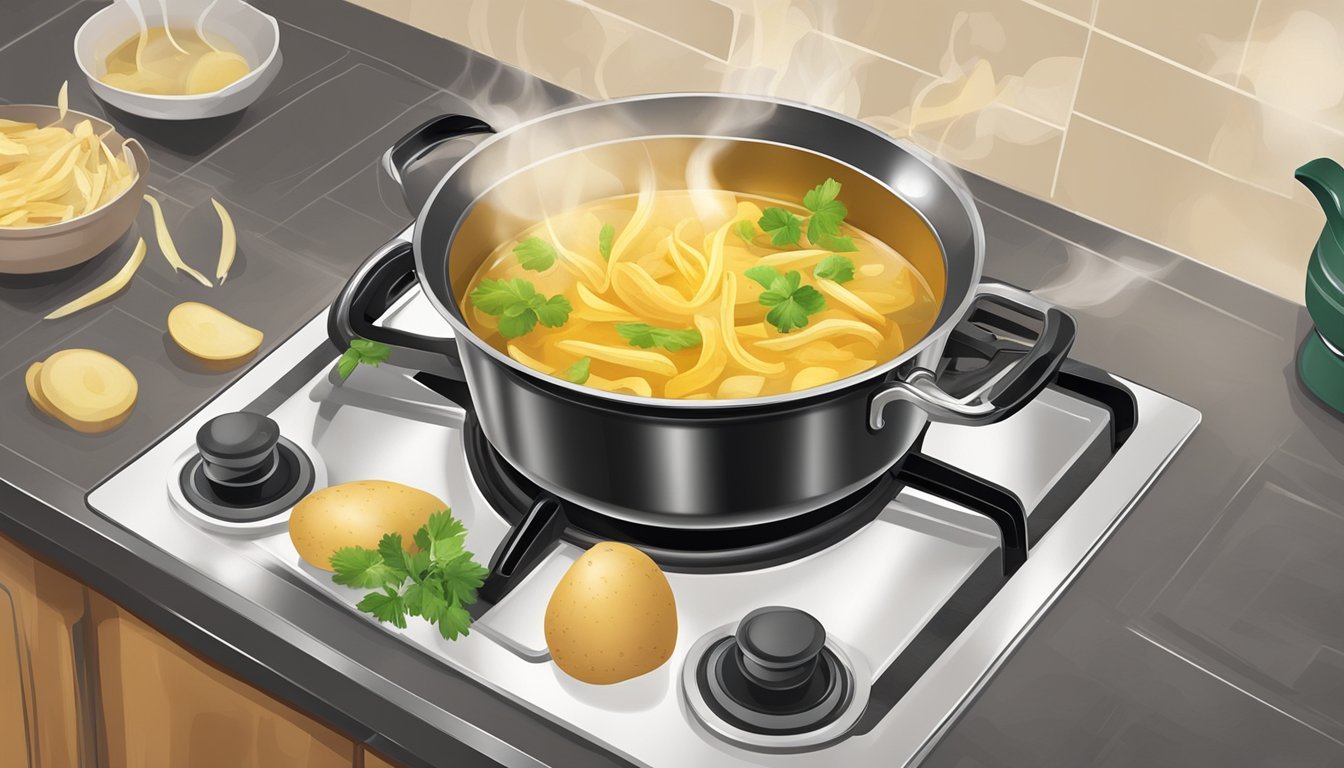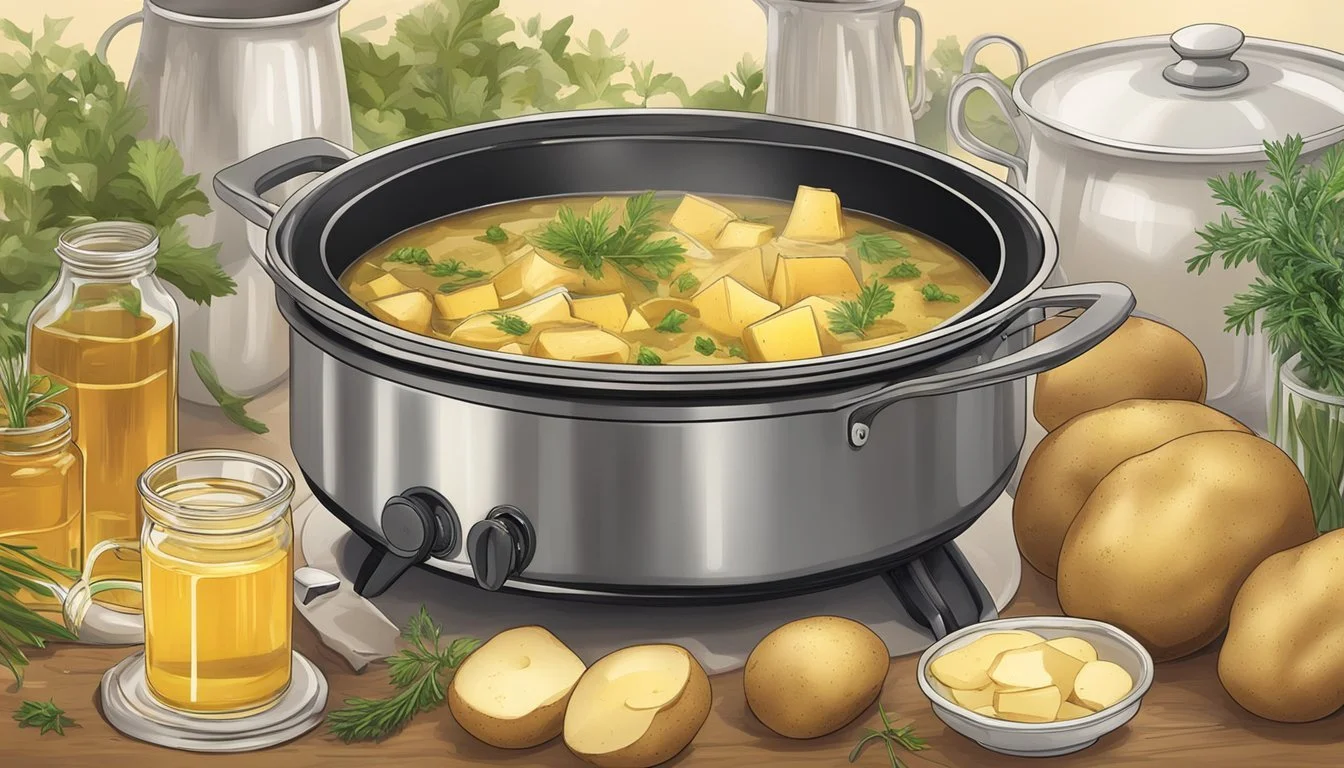Potato Peel Broth
A Hearty, Comforting Base for Nutritious Soups and Stews
Potato peel broth is gaining popularity as a sustainable and nutritious option in kitchens around the world. Often overlooked, the peels of potatoes (What wine goes well with potatoes?) are rich in vitamins and minerals, particularly potassium, and contain both fiber and antioxidants. By transforming these peels into a hearty broth, cooks are not only maximizing the use of their produce but also creating a flavorful base that can serve as the foundation for numerous dishes. The simplicity of making potato peel broth allows it to be accessible to both novice cooks and seasoned chefs, making it an advantageous addition to any culinary repertoire.
This broth is versatile and can be tailored to a variety of dietary preferences, including vegetarian and vegan diets. The process involves boiling the potato peels with a mix of vegetables and herbs, which not only infuses the broth with nutrients but also imparts a comforting and savory flavor profile. Once the vegetables are softened and their flavors meld, the broth can be strained for a clear liquid. The result is a rich, warming, and comforting broth that can be used as a base for soups, stews, or even as a nutrient-dense drink on its own.
By harnessing the humble potato peel, the creation of a potato peel broth exemplifies an approach to cooking that is resourceful and mindful of food waste. It aligns with sustainable cooking practices, as it encourages using parts of produce that might normally be discarded. In a world where food conservation is increasingly important, potato peel broth stands out as a practical, healthy, and environmentally friendly culinary practice.
The Essentials of Potato Peel Broth
Potato Peel Broth is a sustainable way to utilize food scraps while creating a nutritious and warm base for a variety of dishes. This section delves into the key ingredients and the step-by-step process needed to craft a rich, flavor-packed broth.
Key Ingredients for a Flavorful Foundation
Potatoes: The star of the broth, potato peels impart a nutritious and rich flavor.
Water: The solvent of the broth; it extracts flavors and nutrients from the ingredients.
Seasonings:
Salt (Celtic sea salt is recommended)
Freshly ground pepper
Herbs and spices (optional but enhance flavor)
A successful Potato Peel Broth hinges on both the quality of the potato peels and the balance of seasonings. It's imperative to thoroughly wash the peels before use to ensure cleanliness.
The Broth-Making Process
Combine Ingredients: In a large pot, add together potato peels, water, and any desired seasonings.
Cooking:
Bring the pot to a boil to initiate the cooking process.
Reduce the heat, allowing the broth to simmer for about 1 to 1½ hours. This slow cooking process is crucial as it gently coaxes flavors out of the peels.
Adjusting and Finishing: Throughout cooking, adjust the water level to keep the peels submerged and season to taste. After fully simmering, strain the broth to remove the solid ingredients, leaving behind the clear, flavorful liquid.
The precise simmering time can vary based on desired intensity of flavor, but it typically ranges between 45 minutes to 1½ hours, as demonstrated in the provided search results. It's important to note that the potato centers are discarded since they can leach minerals from the body. What remains is a hearty and comforting broth ready to be used as a base for soups and other culinary creations.
Enhancing the Broth
Enhancing the potato peel broth involves carefully chosen additions that enrich the flavor and nutritional content. Each category of ingredients plays a crucial role in transforming a simple broth into a complex and satisfying base for a variety of dishes.
Seasoning and Spices
The foundation of a great broth is proper seasoning. Salt and pepper are indispensable in creating a well-rounded flavor profile. They recommend starting with a pinch of salt and a dash of pepper and adjusting accordingly to taste. Here's a basic guide for seasoning:
Salt: Start with 1 teaspoon per quart of water; adjust to preference.
Pepper: A few cracks of freshly ground pepper for a bit of heat.
Adding Vegetables for Depth
Vegetables significantly bolster the broth's character. Adding carrots and celery enriches both the nutritive value and the taste. These ingredients should be simmered until they are soft, lending a subtle sweetness and an earthy tone to the broth.
Carrots: Peel and dice 1 cup of carrots.
Celery: Chop 1 cup of celery, leaves included for extra flavor.
Aromatics and Herbs
Aromatics such as onions (What wine goes well with onions?) and garlic introduce a savory depth while a careful selection of herbs can provide bright and aromatic undertones. These components should be added at the beginning of the simmering process to sufficiently infuse the broth.
Onions: Add 1 diced medium onion.
Garlic: Include 2 minced cloves of garlic.
Herbs: Bay leaves, thyme, or rosemary sprigs enhance the broth's complexity; add to taste.
Variations & Special Diets
Potato peel broth serves as a versatile foundation accommodating various dietary requirements. Whether one adheres to a vegan lifestyle or has specific health-related restrictions, this broth can be easily adapted to suit an array of nutritional preferences.
Vegan and Vegetarian Options
For those following a vegan or vegetarian diet, potato peel broth is an inherently suitable choice, being plant-based. Traditional broths often incorporate animal-based ingredients for flavor, but potato peel broth derives its deep, rich taste from vegetables alone. Key substitutes to enrich the broth include:
Creaminess: Replace dairy cream with coconut milk or an unsweetened non-dairy milk alternative.
Umami Flavor: Add nutritional yeast or tamari sauce for a cheese-like flavor.
Adjustments for Other Dietary Preferences
Those with specific dietary needs can further personalize potato peel broth:
Gluten-Free: A naturally gluten-free option, this broth typically requires no modifications to fit a gluten-free diet.
Dairy-Free: As mentioned, coconut milk can provide the rich texture often contributed by dairy.
Individuals can introduce a variety of herbs, spices, and vegetables to cater to personal taste preferences, ensuring a flavorful and nourishing result.
Potato Peel Broth Recipes
Potato peel broth serves as a nutritious foundation for soups and stews, utilizing what would otherwise be kitchen waste. It offers a rich taste to a variety of comforting dishes.
Classic Potato Peel Soup
For a traditional potato peel soup, one needs to simmer the well-cleaned potato peels in water along with aromatic vegetables like onions, carrots, and celery for about 1 to 1.5 hours. After the vegetables become soft, straining the broth provides a clear, flavorful base. This broth can be used as a standalone soup or enriched with cream, seasoning, and additional vegetables for a heartier potato soup recipe.
Ingredients:
Potato peels
Onion, quartered
Carrots, large pieces
Celery, large pieces
Garlic
Water (1.5 liters recommended)
Salt and Pepper to taste
Instructions:
Combine potato peels, onion, carrots, and celery in a large pot.
Fill pot with water and bring to a boil.
Reduce heat and simmer until all vegetables are soft.
Strain to obtain a clear broth and adjust seasoning as needed.
Innovative Uses for Potato Peel Broth
Potato peel broth, while typically used in soups, can be incorporated into a potato stew for an even heartier meal. Creative additions like garlic, ginger, tomatoes, and seasoning can enhance the broth. After boiling and blending these ingredients, this enriched broth can be used as a versatile component in various dishes such as a loaded potato soup, where one can add cheese, bacon, and chives as toppings.
Loaded Potato Soup:
Additional Ingredients: Chopped bacon, shredded cheese, chives, cream
Steps:
Prepare the enriched potato peel broth as outlined above.
Pour the broth into a pot, add peeled and diced potatoes and cook until tender.
Stir in cream, cheese, and cooked bacon.
Garnish with chives before serving.
Cooking Techniques
This section outlines practical methods for preparing potato peel broth, emphasizing key equipment and steps for both conventional and modern cooking appliances.
Stovetop Method
Using a Stovetop: One begins by combining ingredients in a large pot—typically, an 8-quart size is sufficient. They will bring the mixture to a boil before reducing it to a simmer. It's crucial to maintain a gentle simmer for approximately 1 to 1½ hours, or until the ingredients are soft. Additional water may be needed to keep everything submerged. For a clear broth, one strains the solids and discards them.
Instant Pot and Slow Cooker Adaptations
Instant Pot: To adapt the recipe for an Instant Pot, they'll need to select the 'Soup/Broth' setting after adding the ingredients to the pot. The pressure cook function reduces the cooking time significantly—usually, 30 minutes on high pressure is ample, followed by a natural release of pressure.
Slow Cooker: If they opt for a slow cooker, the ingredients can be combined and cooked on low for approximately 6 to 8 hours, or on high for 3 to 4 hours. This method is ideal for extracting flavors slowly and can be left unattended.
Preparation Tips
When making potato peel broth, efficiency in preparation is key. The following tips are aimed at ensuring a smooth process from peeling potatoes to achieving a creamy texture.
Peeling Potatoes Efficiently
For quick and effective peeling, one should opt for using a sharp vegetable peeler. Starting from one end, peel away from the body using long, even strokes. Using russet potatoes is recommended as they not only have a thicker skin that's easier to peel but also yield a starchier broth which can contribute to a richer flavor. Ensure all potatoes are washed thoroughly before peeling to remove any dirt or contaminants.
Expert Blending for Creaminess
To achieve a creamy texture, blend the cooked peels and vegetables until smooth using an immersion blender. This method allows for control over the consistency of the broth; one can blend directly in the pot. For a truly creamy broth, the blend should be processed at a steady pace and moved around the pot to include all pieces. If an immersion blender is not available, a standard blender can be carefully used in batches.
Serving Suggestions
Potato peel broth serves as a nutrient-rich and flavorsome base, offering a versatile canvas for a variety of toppings and meal pairings. The right accompaniments can transform it from a simple broth to a hearty and comforting meal.
Accompaniments and Toppings
One can enhance the richness and complexity of potato peel broth with a selection of toppings. Seasoning is key; a proper balance of salt and pepper is essential. Aromatic onions sautéed until golden can add depth, while green onions or chives provide a fresh contrast. For a touch of creaminess, a dollop of sour cream works wonders. For those who enjoy a bit of crunch and a smoky flavor, bacon crisped to perfection is an excellent topping.
Seasoning: Start with a base of salt and pepper and adjust to taste.
Onions: Sautéed until golden for a sweet and savory addition.
Green Onions/Chives: Sprinkle on top for a fresh, sharp flavor.
Sour Cream: Add a dollop for creaminess and tang.
Bacon: Crispy bacon bits for a smoky, crunchy topping.
Pairing with Meals
Potato peel broth, while delightful on its own, also pairs well with a variety of meals. For a lighter fare, one might serve it alongside a fresh salad or steamed vegetables. If one desires a more substantial meal, the broth can be enjoyed before a main course of roasted meats (What wine goes well with roasted meats?) or baked fish, which complement its hearty and comforting notes.
Lighter Fare: Combine with a fresh salad or steamed vegetables.
Hearty Meals: Serve as a starter to roasted meats or baked fish.
Storage & Preservation
Proper storage and preservation of potato peel broth not only extend its shelf life but also maintain its flavor. It is crucial to store the broth correctly to ensure it is safe for consumption.
Cooling and Storing the Broth
Once the potato peel broth has been prepared, cooling it promptly is essential. The broth should be allowed to reach room temperature. After cooling, it can be transferred into a refrigerator-safe container. The broth should then be sealed tightly and placed in the refrigerator. Ideally, one should consume it within two to three days for the best quality.
Freezing for Later Use
For long-term preservation, freezing is a practical option. Portion the cooled broth into freezer-safe containers or ice cube trays for convenience. Labeling each container with the date of freezing assists in tracking how long the broth has been stored. Potato peel broth can be frozen for up to three months. When ready to use, simply thaw in the refrigerator or reheat directly over low heat, ensuring it reaches a safe temperature throughout.
Advanced Topics
Exploring the advanced topics of Potato Peel Broth, one discovers both the intricate nutritional benefits it offers and the rich cultural heritage embedded in potato-based dishes.
Nutritional Insights
Potato peels are a source of valuable nutrients such as fiber, which is essential for digestive health. They contain vitamins, particularly vitamin C and B vitamins, as well as minerals like iron, potassium, and magnesium. By transforming these peels into a broth, they provide a healthy and low-calorie base that is not only filling but also rich in nutrients.
Nutrient Benefit Fiber Aids in digestion Vitamin C Supports immune function B vitamins Contributes to energy release Iron Essential for blood health Potassium Regulates fluid balance Magnesium Supports muscle and nerve function
Cultural Significance of Potato Dishes
Potatoes have long been a staple in many cultures around the world, known for their role in traditional and comfort food cuisine. Potato peel broth is no exception, carrying with it the legacy of tradition and sustenance. In some regions, it is seen as an innovative way to reduce waste while paying homage to the humble potato. As a comfort food, potato-based broths and soups are universally recognized for their warmth and heartiness, making them a beloved dish in various culinary traditions.
Conclusion
Potato peel broth stands as a testament to sustainable cooking, transforming what is often considered waste into a valuable culinary asset. The peels, simmered with a mélange of vegetables, impart a robust flavor and are an excellent way to extract every bit of nutritional value from the humble potato.
The process is straightforward: by combining peels with water and a choice of herbs and vegetables, one can create a base that is both healthful and flavorful. This broth forms the perfect foundation for various dishes, ranging from rustic stews to sophisticated soups. Key points to remember when making potato peel broth include:
Simplicity: A few basic ingredients can yield a rich and aromatic broth.
Versatility: Customizable with a variety of spices and additional vegetables.
Sustainability: Utilizes food scraps, reducing waste and encouraging more eco-friendly cooking habits.
The practice of making potato peel broth is not only an exercise in culinary creativity but also a step towards more ethical cooking methods. It exemplifies how resourcefulness in the kitchen can lead to delicious outcomes. Chefs and home cooks are encouraged to explore this technique and discover the many ways in which potato peel broth can elevate their cooking.

